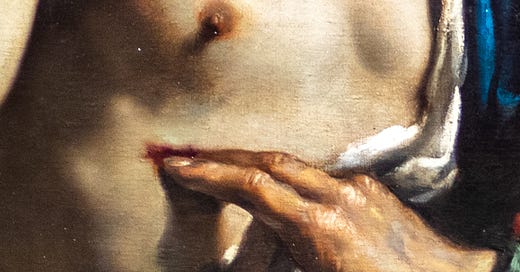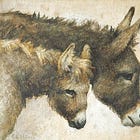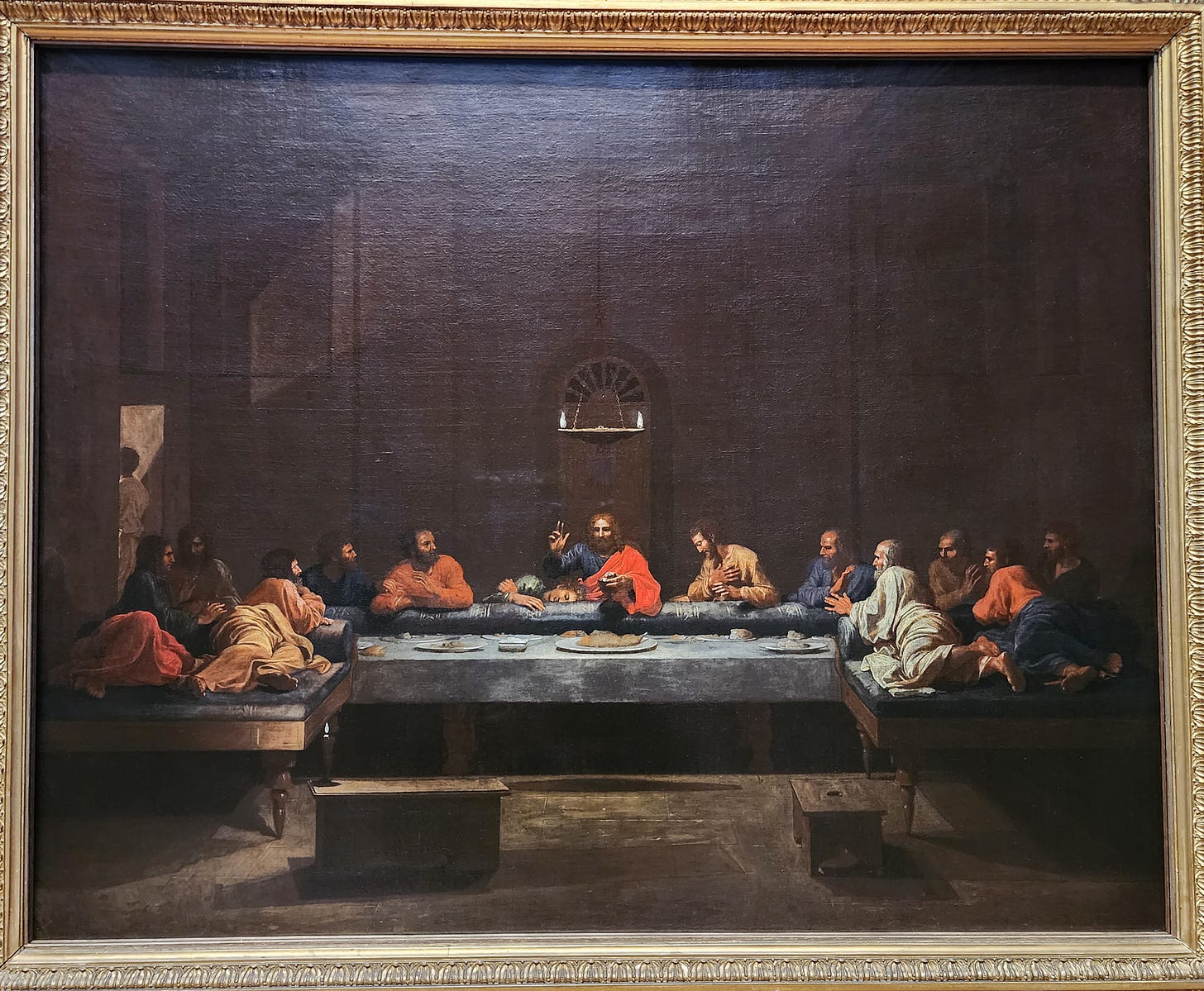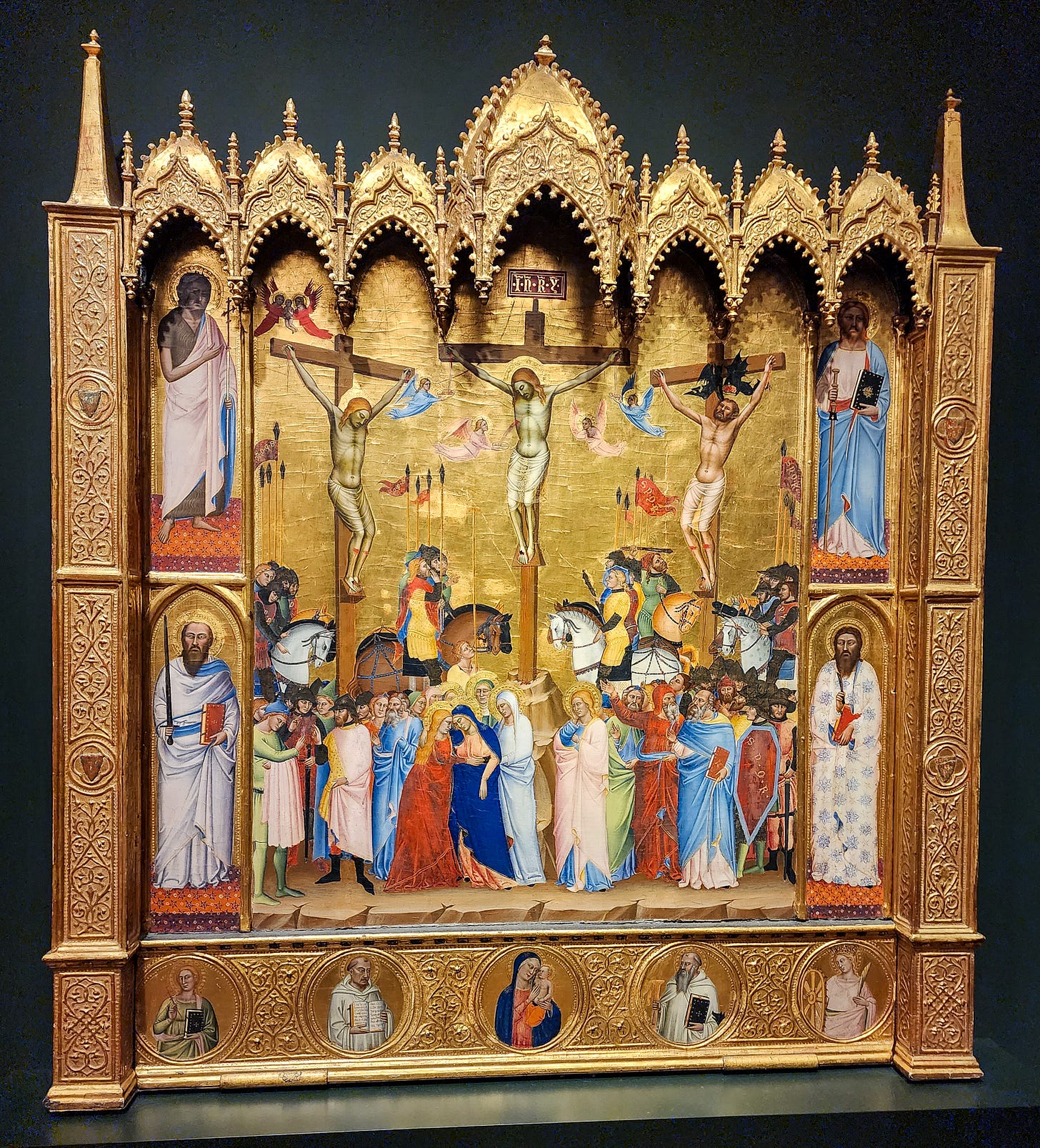After Holy Week at the National Gallery London
Just two paintings found to mark after-Easter events (and Holy Week Pilgrimage recap)
There were two paintings representing post-Holy Week and Easter events at the National Gallery:
Noli me Tangere. Titian. (ca. 1514). Oil on Canvas.

“Risen from the dead, Christ appears to his grieving follower, Mary Magdalene, in the Garden of Gethsemane. At first she mistakes him for a gardener but then reaches out her hand in wonder. Christ says, ‘Do not touch me’ (in Latin, noli me tangere); it is time for his followers to let go of his earthly presence and await the Holy Ghost (John 20: 14–18). The focus of the picture is on the interplay of gesture and gaze between Christ and Mary Magdalene. We do not know for whom the picture was painted.
This is one of the earliest works by Titian in the National Gallery’s collection. Its high-key colours and the way the figures are set in a natural landscape echo the style of Giorgione, with whom Titian trained. Titian had already succeeded in uniting figures with the landscape five years earlier in The Holy Family with a Shepherd, but here he has done something more subtle and sophisticated – the hills, trees and shrubs play a part in the drama. The intersecting lines of the tree and the hillside draw attention to the line of eye contact between the figures. This was an approach that Titian was to develop further in his great altarpiece The Death of Peter Martyr, completed in 1530 (for SS. Giovanni e Paolo, Venice, but now destroyed), where the trees contribute dynamically to the action.
The figure of Christ is in a graceful and entirely believable sinuous, twisting pose which reveals Titian’s increasing understanding in this period of the nude and its dynamic potential. This must partly have been due to his study of prints of and drawings after works by Raphael and Michelangelo, who each in their way made the articulation of the nude figure and the study of antique sculpture central to their practice.
The group of buildings on the right appears in reverse in Titian’s Sacred and Profane Love (Borghese Gallery, Rome), which is dated fairly securely to about 1514, as well as in his Sleeping Venus (Gemäldegalerie, Dresden) of around the same time. The rendering of Noli me Tangere, however, is particularly evocative in its observation of the tumbling mists and play of light across the fields as dawn breaks. We also see the expressive brushwork and interest in the textural possibilities of paint that became the hallmark of Titian’s mature and late styles. The whites of Mary Magdalene’s veil, of Christ’s flowing burial shroud and his loincloth are subtly differentiated, each rendered with dragged brushstrokes of lead white that catch the texture of the painting’s canvas.
Noli me Tangere probably also dates to about 1514. X-ray images reveal that Titian made numerous changes to the landscape during painting but he never seems to have shown the empty tomb or Calvary – the hill on which Christ was crucified – included by almost all other artists painting this subject.”1
The Incredulity of Saint Thomas. Guercino. (ca. 1621). Oil on canvas.

“The New Testament recounts how, after his crucifixion, Christ rose from the dead and appeared to his apostles. One of them, Thomas, was absent and refused to believe Christ’s resurrection without witnessing it himself. This painting shows their encounter, when Christ instructed Thomas to touch the wounds he had suffered on the Cross.
The action takes place in semi-darkness before a wall, its plaster crumbling at the top to reveal the brickwork beneath. Fingers outstretched, Thomas tentatively reaches towards Christ, clutching his other hand to his chest; we can sense his nervousness. Two men lean in behind him, craning their necks to see, while Saint Peter looks on over Christ’s shoulder. Guercino has built a powerful sense of anticipation and tension through the picture’s tight crop and dramatic lighting. The figures, transfixed by Christ, watch and wait to see what will happen.
Cropped at three-quarter length, the figures crowd the space, bringing us closer to the action and focusing our attention on the interaction between the protagonists. Guercino has chosen to illustrate the most dramatic moment in the story, and the one which evokes the most powerful emotional response: Thomas coming into physical contact with Christ. Time is suspended at the crucial moment just before Thomas’s realisation; it is as if we – and the onlookers – are holding our breath.
Christ, his right arm drawn back to reveal his wound, looks benevolently at Thomas. In his left hand he holds a wooden standard with a white flag, a symbol of his resurrection. The strong vertical of the pole divides the image in half. On one side we are presented with the steadfast, knowing Christ; on the other, in a hunched pose and with his face cast in shadow, we see doubting Thomas. The illuminated Christ acts as a beacon within the dark composition and the use of light is symbolic: Thomas, who hasn’t yet ‘seen the light’, is about to experience a revelation.
This picture’s sense of drama, lighting and naturalism owe much to Caravaggio, whose influence was widely felt in the early seventeenth century. Painted in 1621, this work was made by Guercino just prior to his move to Rome in May of that year. It is one of a pair of pictures painted by Guercino for Bartolomeo Fabri, its pendant being The Betrayal of Christ in the Fitzwilliam Museum, Cambridge. Originating from Cento, the town near Bologna where Guercino was born, Fabri was an important early patron for the artist. He commissioned other works from him, including The Presentation of Jesus in the Temple, also in the National Gallery’s collection, which dates from just two years later.”2
A Holy Week Pilgrimage: The Paintings and Stories
Contemplations on This Pilgrimage
It was interesting how few representations the National Gallery London have of Palm Sunday/Triumphal Entry and of Easter/Resurrection Sunday. On the Holy Week theme, by far the greatest number of depictions were for the events following the Crucifixion, especially the Lamentation.
Because of the absence of Palm Sunday paintings at the Gallery, I went searching afield.
I learned of Triumphal Entry paintings at the Indianapolis Museum of Art, Scrovegni Chapel, Padua, Italy, the Lower Basilica of San Francesco, Assisi, Italy, and the L’abbaye Saint-Germain-des-Prés, Paris, France
To my “Life List,” I added “View the frescoes of Christ’s life at the L’abbaye Saint-Germain-des-Prés and stare up at them as long as I desire.” And, closer to home for this Californian, “Go south to the Getty Center in Los Angeles to see the illuminated manuscript miniature of Judas accepting the 30 pieces of silver, a subject not well-represented in art.”
I learned about the Brooklyn Museum of Art and of the artist James Tissot and his prolific works on the life of Christ, 300+ of which are housed there. Visiting this museum and viewing these small watercolors is also now added to my “Life List”.
A stark and precious memory of viewing the Florence Baptistery Bronze doors struck me and a fierce longing to return to Firenze, and those doors, has welled up inside me.
Must also visit: Chrysler Museum of Art in Norfolk, Virginia.
“El Greco”— “The Greek” — was born Doménikos Theotokópoulos on the Greek island of Crete.
Spikenard is a very interesting and fragrant plant, the oil of which (used by Mary to anoint Jesus’s feet) is supremely costly because the plants are grown and harvested in the Himalayas. It would be fascinating to study the ancient trade routes of the first century AD…and retrace spikenard’s route myself from the plant growing at 11,000-17,000 feet in Nepal and then along the 6000 mile path to Jesus’s feet!
A triclinia is a Roman reclining couch and some scholars believe these were likely what the disciples and Jesus used at their Passover Dinner:
I learned about a UK Governmental program called the “Acceptance in Lieu Scheme” whereby individuals are allowed to settle inheritance tax or estate duty by transferring important cultural, artistic, or historical objects to public ownership. “In lieu of” paying their obligation to the government in cash, individuals can settle their debt by giving objects or artworks of major cultural significance and value to Britain, ensuring that these great works of art remain within the UK.
One of my favorite paintings from the National Gallery this week was Christ Before the High Priest by Gerrit Van Honthorst (c. 1617) with that visible light source, its glow, and perspective, bringing us into the scene.
I am also completely taken with The Crucifixion by Jacopo di Cione (c. 1369-70) with all its splendid detail. I could gaze at it for a very long time. I think I shall, one day…
Preparing Jesus for burial and placing Him in the tomb was a bit of a rushed affair as it needed to happen before sunset. Joseph of Arimathea portrayed immense courage in asking Pilate for Jesus’s body, and immense physical strength in taking the lead (at least) in removing Jesus from the cross. The fact that Joseph’s new and unused tomb was very close undoubtedly helped him, and Nicodemus, in preparing and burying Him while adhering to Jewish Sabbath laws.
Michelangelo likely stopped working on the unfinished Entombment altarpiece in Rome because he was offered a great big block of Carrara marble in Florence, from whence came His masterpiece, David (housed at La Accademia in Florence).
Creating a cross-comparison and succinct(ish) narrative of the Holy Week scriptures was a big and vivifying challenge for me.
Remembering last year’s very first Maundy Thursday service brought a great sense of vulnerability at the sharing of it but it brought a greater sense of Jesus’s humility and love towards me and the rest of humanity. It was an identity-sealing occurrence in my life, that Maundy Thursday service. To approach the world with the same humility and love with which Jesus approached His disciples at the Last Supper and with which He approached me through the influence of the vicar at Queen’s Gate, that is what I hope to do, also. That is how I hope to be in this world.
Thank you for joining me on this journey through Holy Week at the National Gallery London. I think it will be great fun to choose other themes and quests at museums and galleries—and perhaps on city walks and in National Parks and other places—in the future. If you have any ideas, please let me know!
https://www.nationalgallery.org.uk/paintings/titian-noli-me-tangere
https://www.nationalgallery.org.uk/paintings/guercino-the-incredulity-of-saint-thomas

















Quite a journey! This was fascinating to go through and I appreciate the effort you put into creating this for us. I have been exposed to more classical art through this than I have in years, likely.